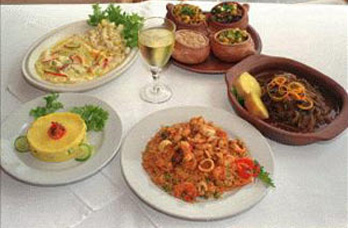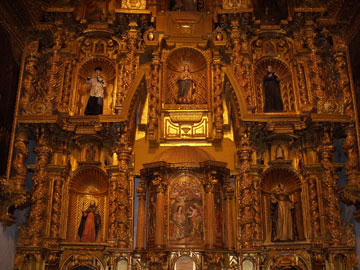Samples of Special Interests
Archaeotourism
Archaeological tourism (sometimes labeled “archaeotourism”)
is
travel that focuses on visiting and experiencing ancient sites and
historical places. The motivating forces behind archaeological
tourism are a passion for the past and an interest in learning about
the ancient or historical cultures that inhabited the area being visited. “Archaeotourists” are
also attracted by the exotic (and often
hard to access) nature of the locations in which many archaeological sites
are found and often desire unique experiences. Archaeological tourism may include
visits to museums, places of historical significance, historically and archaeologically
focused parks, and even attendance at traditional dances, festivals, and other
events. Archaeological tourism combines a passion for the past with a sense
of adventure
and discovery.
We follow guidelines and laws that mandate “good practices” for
visiting sites. We are concerned with unregulated tourism which has led
to the deterioration and destruction of sites around the world. Archaeological
sites and historical places are finite, fragile, and non-renewable resources.
Peruvian Cuisine
Expedition
Cultural
Expeditions Peru offers exclusive cookery tours to Peru's unique cuisine
that incorporated influences from different times and cultures. This culinary
history dates back to the Incas and pre-Incan cultures. Our expeditions
allow clients to indulge their passion for food, cooking and culture.
We
experience guided tours to wine vineyards, colorful food markets along
with the famous local sights of Peru. Dine in elegant top-rated Peruvian
restaurants and authentic ethnic local food establishments.
The exact week's
schedule will depend on the week of your travel and your chosen venue and
we also make the most of the seasonal highlights and fiestas. You learn
from professional tutors who have a passion for Peruvian
cuisine.

Weaving Techniques
and Ancient Textile Expeditions
Weaving was a fundamental
activity for all Andean pre-Columbian civilizations, because clothes and
textiles had a value in the eyes of Andean peoples that was not much less
than that of jewels and precious metals. The art of weaving vegetal fibers
was also the first means of artistic expression in pre-Columbian Peru (history
of textiles in Peru) and predated pottery
making and metalworking.
We experience first hand weavers, spinners,
dyers, and learn about the the unique weaving systems that are still in
use today, including the tabular weaves, threading of tricolor complementary
weaves, and the heddles of dual-lease weaves. We meet an Andean woman that
worked with researchers on preserving themes and techniques of weaving
in the Andean community. She traveled extensively to the U.S. to organize
weaving exhibits with several universities and the Textile Museum of Washington
D.C. She has organized courses where we can weave with the various local
artesians in their unique local traditions.
While in Lima, we explore the
superb museums and private collections of pre-Columbian textiles (timeline
of cultures and arts) with a Peruvian
specialist in the textile area, and participate in ancient pre-loom techniques
and basketry using reeds and grasses. The expedition members experience
the techniques of the ancient traditions that identified the residents
with their particular locality, and also meet with present day weavers.
We also see folk art in various media such as clay and silver,
as well as observe their unique and famous retablos. Plus, explore early
Spanish colonial art which blended the Spanish and indigenous arts into
new art forms. It will be delightful to hear the music of the panpipes,
harp and charangos, and be captivated by the local dances of the festivals.
The mystery of the ancient archaeological sites will amaze you, while the
colorful outdoor markets, charm of the villages and tastes of the savory
ethnic food will create treasured memories for years to come. An added extension to
the Nazca or Lake Titicaca areas will add additional textile experiences
to the itinerary.
Expedition
on Ancient Peruvian Pottery Techniques
Ancient Peruvian peoples have
left us remarkable and varied examples of their pottery production. Peruvian
pottery was produced by two fundamental techniques: one was the coil method
, and the other, particularly widespread along the northern coast, used
molds. Vessels have also been found that were produced using both techniques.
There were also various methods of decoration: painting,
which could be applied before or after firing; incision; modeling in relief;
and three-dimensional decoration. Peruvian potters had the choice of a
wide range of colors.
A fabulous collection of these beautiful pieces of pre-Columbian
pottery can be visited in the Museums
of Lima and Cusco along with a specialist guide in the area of Pre-Columbian
pottery. In this trip we experience three different areas with three different
ceramists and their techniques.

Early Spanish Colonial
Arts Expedition
The Spaniards introduced a
new religion, new forms and styles of European art to the peoples of the
Andes after the conquest in 1532 by Pizzaro. In the beginning these changes
were imposed but in time they were accepted and assimilated and eventually
were integrated in the fabric of colonial life. Two different worlds met
and produced something new.
In the history of art this transformation is
revealed through the innovative changes in style, iconography, and through
the emergence of local artists and themes. Spain's Moorish influence
is also seen along with the presence of the defeated Inca empire particularly
in Cusco. The mestizo emerged and ethnic groups and their flora and fauna
of South America were introduced. All these subtle changes developed
into Spanish
colonial architecture and art as seen
in painting, sculpture and the decorative arts which reveals the emergence
of Peru's national identity.
The artistic heritage of the
Americas stands as a unique contribution to the history of art and architecture
and we experience its richness and uniqueness. We explore and learn first
hand with the help of art historical specialists two categories that
developed differently because of the context in which they were located.
One was the metropolitan centers, where new ideas and forms were generated
with the influence of European art, and another the rural areas where
these new ideas and forms were integrated into yet earlier pre-Columbian
expressions.
Add Special
Interests to Your Tour to Peru
A
tour can be designed to include educational interests
such as:
Archaeological tourism (archaeotourism),
pre-Columbian pottery,
Peruvian textiles and weaving,
cultural history,
family home stays,
spiritual tours and Andean rituals
early Spanish colonial
arts,
Andean cuisine,
Andean spiritual tours,
pre-Columbian and Colonial architecture and archaeology,
Peruvian horses,
birdwatching,
Spanish language immersions,
ancient and contemporary horticulture,
ancient mining techniques.
Include areas of activities
such as:
Inca
Trail,
trekking other trails,
boat rides
on Lake
Titicaca,
horseback riding,
river
rafting,
flyfishing,
mountain
biking,
paragliding in Lima
preservation or social projects can also be included.
We can also tailor your trip with
various unique intercultural events and hands-on cultural encounters. We
specialize in customized luxury experiences tailored to your groups interests
and are committed to providing in-depth interdisciplinary expeditions that
experience Peru's Spanish and Andean history, archaeology, arts and culture.
We organize an expedition for any size group of
close friends or family members, couples, honeymoon couples, university
students or alumni, members of museums, clubs or other organizations, a
business associates group, high school expeditions, senior center groups
or travel clubs.
Personalized attention to your particular needs is our specialty.
We work with renowned, top-of-the
line tour operators, guides and specialists in each area of interest.
Private
expeditions are priced individually according to the length
of the expedition, what activities and extensions are included, the number
of participants, the category level of the accommodations, special lecturers
and guides presenting educational material, meals and extra services that
are included.
What makes the difference is the richness and caliber of
your experience.
Contact us for detailed information and pricing.
Andean Spiritual Tours
Join a pilgrimage into the ancient land and
traditions of the Incas, not a tour of a foreign country. Our Peruvian guide,
Jorge Luis Delgado is a native Peruvian of Incan descent. He
takes a group to all of the popular, and some little known, Inca sites
in the Sacred Valley around Cusco and into Machu Picchu as well as in the
area of Lake Titicaca. You would have a ceremony
very night with a shaman from the Quero community of Asangate Mountain
near Cusco, Peru. You would meet the
indigenous shaman of the area and participate in their rituals.
Jorge offers his services as a tour guide of the ancient
core beliefs of the Incas, with practical applications to enrich and expand
your life experiences. It is time to transform modern life and enrich our
connectedness, as we embrace our heritage as Children of the Sun. Knowledge
of the ancient Inca spiritual teachings and their application in today's
world. Peru has a worldwide reputation for its archaeological and cultural
treasures from Andean pre-Incan societies culminating in the Inca Empire.
Time is used to learn and understand the social, cultural and religious aspects
of their society as it is today, and we can also venture into the history
of their ancient sites and civilizations, and the learn about the beliefs
that founded their existence, still alive today. We can rediscover that place
by connecting to the consciousness that inspired their creation.
According
to the Andean Cosmic Vision, as well as The Spiritual & Healing Tradition
of the Peruvian Coastal & Amazon Cultures, one must go through Munay.
The Capacity to Love to make social and ecological agreements authentic.
They use ceremonies that are very connected to nature, to the spirit world,
and to sacred healing plants. They resonate with healing vibration of each
person, tuning their frequency, balancing, and harmonizing their energy fields
with the currents that move through the sea, mountains, and jungle.
The Elders are opening their hidden Wisdom. They are giving us guidelines on
how to transform personal and environmental toxins, how to heal the planet and
ourselves. They are providing more information about human consciousness; they
are helping us on how to continue in this immense restructuring that is altering
our perception of reality as well as our role in shaping it.
Sign up now for:
Andean Awakening Tour Machu Picchu, Sacred Valley & Lake Titicaca,
Peru
May, 2011
for more information click here
Learn Spanish in Cusco
Spanish Immersion in Peru
Learning Spanish in Cusco Peru is one of the programs offered
by Cultural Expeditions Peru. Peru is renowned as the land of the Incas but
many great pre-Columbian civilizations flourished in the past. Visitors can
see the ancient ruins of the Inca capital of Cusco, and explore the lost
city of Machu Picchu as well as ruins from a variety of other cultures including
the Nazca, Chimu, Wari and Moche.
Surrounded by Inca history and offering the comforts of
an internationally known town, Cusco truly is an exciting place to learn
Spanish. Once the capital of the great Inca civilization, Cusco is also
home to magnificent examples of colonial architecture. The stone foundations
of Inca temples are still visible in the colonial buildings around the
city. Another fun activity is to seek out the many Indian markets selling
the beautiful wool sweaters and textiles of Peru.
Orchid Expedition
Peru is the home of 3,000 orchid species,
found from Tumbes in the north and Puno in the South, and more species are
being discovered. In Lima species like the Chloraea undulata, Aa mathewsii
and Porphyrostachys pilifer (the Little Peruvian) have been catalogued. The
estimates for diversity within the Machu Picchu Historical Sanctuary reach
200. New species are discovered every once in a while like the Ponthieva
sp. nov. (Bennett and Christenson), discovered in May 1998. One fascinating
area is the section from Phuyupatamarca-Intipunku on the Ollantaytambo-Machu
Picchu Inca Trail, which is a region of cloud forests from 3,600 to 2,500
m.a.s.1. The explorer will encounter virgin forests with abundant epiphytes
and bushes. The most frequent genera are: Aa, Epidendrum, Lycaste, Masdevallia,
Maxillaria, Oncidium, Odontoglosum, Phragmipedium and the Sobralia, the most
spectacular being the Masdevallia veitchiana (waqanki, in Quechua).
In Lima we can visit the collectors greenhouses, and then
explore the ancient citadel of Machu Picchu and its orchid collection with
biologist guides or orchid collectors.
Voluntary work with children in Peru
Would you like to help socially and economically disadvantaged
children, practise your Spanish (if you speak it at all, tho' this is not
essential for volunteering) and experience an authentic Andean community
off the usual tourist trail? Then go to www.Tinkuyperu.com to take
your first step towards an unforgettable experience.
e-mail
us with any questions, for more details and pricing


